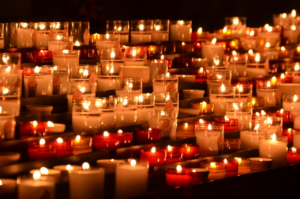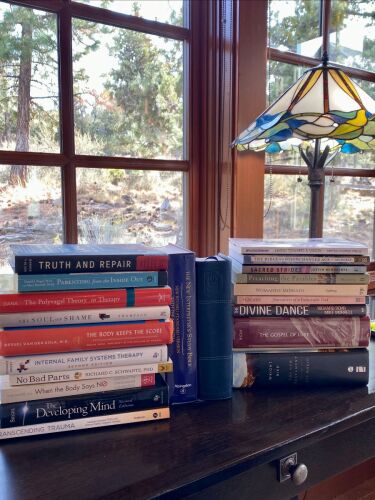 There is so much loss, so much to grieve.
There is so much loss, so much to grieve.
Unrelenting waves of tragic news—deaths from Covid surpassing one million, unprovoked brutality in Ukraine, racist hatred, children gunned down in their classrooms, religious leaders hiding abuse behind hypocrisy.
All of this communal loss on top of your other losses.
How do you deal with the pain? How do you heal?
There are no predictable stages leading in a straight line to resolution and restoration. But there is a process, a practice that supports you through the pain.
The tasks required in a season of grief engage your entire inner family. They need you, their leader and guide, now more than ever. There are protectors diligently attempting to avoid or numb pain, and there are many tender parts burdened by distressing emotions, intense sensations, distorted beliefs, and difficult images.
Yes, a lot is going on inside.
And, you have the God-given resources needed to come alongside each of them, to offer hope in the face of fear and overwhelm.
Your resources are love in action providing the energy of compassion and comfort for the hurting. Clarity and courage infuse protective parts with the confidence that healing is possible. Patience and perspective help the lonely and despairing to see possibilities. There is no limit to love in its myriad forms. The Spirit is present, accompanying you as you tend to the needs of your inner family members.
Your system will have a unique way of responding to loss depending on your history of loss and the nature of the current loss. But some common reactions can help you understand what you’re experiencing.
Our culture minimizes grief.
First, your loss occurred in a culture with a lot of protective energy about grief. Grief and loss are vulnerable, and we are all hard-wired to avoid vulnerability. So we are bombarded by messages to “Get over it” or “Move on.”
I worked in a hospice for four years, hearing clients share stories about what felt like allergic reactions to their grief. There is little tolerance for emotions or the time required to adapt to loss—whether a loved one or any of the myriad losses in life.
The protective members of your internal family are adept at picking up on these messages. They want you to conform to cultural norms. So if others tell you “you should be over it,” that it’s “not good to wallow in sadness,” your protectors will work to block your feelings. You’ll notice how quickly you pivot from tears to telling people, “It’s okay; I’m okay.”
Protectors are also on duty in many spiritual communities.
The vulnerability of loss can provoke attempts to bypass pain with a grab bag of verses taken out of context. My least favorite is, “God won’t give you more than you can handle,” a twisted misstatement of 1 Corinthians 10:13. Some will urge you to focus on “truth,” on beliefs, as though your emotions reveal a lack of trust in God. All of these protective reactions block connection when you most need it.
Protectors seek simple solutions.
If you turn to books or blogs for guidance, you will probably encounter the “five stages of grief,” a model that is not supported by research but persists nonetheless. The simplicity of this model appeals to parts of us; when grief upends our lives, they long for control and predictability amid chaos and uncertainty. It feels comforting to think there’s a linear process, that we can proceed through stages and arrive at a destination.
But “stages” doesn’t describe what actually happens when we grieve a loss.
The most useful models describe the tasks involved in working through the impact of loss.
Tasks include accepting the reality of the loss, processing emotions, adapting to life without the loved one—or other cherished relationship, capacity, or reality—and figuring out the new normal. The path is circuitous; you will revisit all of these tasks repeatedly. They require energy, so feeling tired and foggy is common and natural.
Imagine how these tasks impact the members of your internal family.
Some are bewildered, struggling to accept a new reality. Sadness, fear, loneliness, and anger show up as tension, fatigue, or agitation in your body. These tender parts of you dwell on unanswerable questions.
Their vulnerability provokes protectors, who fear you will be overwhelmed by pain. So they adopt various strategies to block it, including distraction, criticism, and avoidance. In response to cultural messages, they will minimize the loss and pressure you to be “productive.”
No wonder seasons of loss feel chaotic. A lot is going on inside you, and your inner family members need you.
Start by connecting with the ones who are afraid of your pain. Tell them how much you appreciate how they’re trying to help you and ask them if they’d be willing to take a break.
Let them know you can handle being with the ones who are hurting because you have what they need.
As your protectors relax, you will feel confident and compassionate as you turn toward the parts of you who are in pain. When you connect with them, let them know they have your heart and attention. They will tell you how you can help them.
Building relationships with dedicated protectors and vulnerable burdened parts is a spiritual practice.
As you offer loving connection, they will have the safety they need to process loss and work through the tasks it requires. They will know they are not alone—they have you and God’s loving presence for the healing journey.
Whether you’re in a season of loss or you’re accompanying someone who is, be intentional about meeting with the members of your inner family. The deeper your relationship with them, the more access you’ll have to the God-given resources you need for this tender time.




Leave A Comment